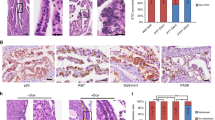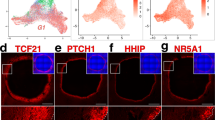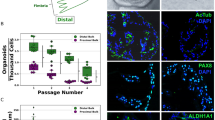Abstract
Recent studies suggest that some serous ovarian carcinomas (SOCs) arise from the fallopian tube (FT) epithelium rather than the ovarian surface epithelium. This hypothesis places emphasis on the FT secretory epithelial cell as a cell-of-origin. Herein, we report the development of a novel ex vivo primary human FT epithelium culture system that faithfully recapitulates the in vivo epithelium, as shown by morphological, ultrastructural and immunophenotypic analyses. Mass spectrometry-based proteomics reveal that these cultures secrete proteins previously identified as biomarkers for ovarian cancer. We also use this culture system to study the response of the FT epithelium to genotoxic stress and find that the secretory cells exhibit a distinct response to DNA damage when compared with neighboring ciliated cells. The secretory cells show a limited ability to resolve the damage over time, potentially leaving them more susceptible to accumulation of additional mutagenic injury. This divergent response is confirmed with in situ studies using tissue samples, further supporting the use of this ex vivo culture system to investigate FT epithelial pathobiology. We anticipate that this novel culture system will facilitate the study of SOC pathogenesis, and propose that similar culture systems could be developed for other organ site-specific epithelia.
This is a preview of subscription content, access via your institution
Access options
Subscribe to this journal
Receive 50 print issues and online access
$259.00 per year
only $5.18 per issue
Buy this article
- Purchase on Springer Link
- Instant access to full article PDF
Prices may be subject to local taxes which are calculated during checkout





Similar content being viewed by others
References
Ando H, Kobayashi M, Toda S, Kikkawa F, Masahashi T, Mizutani S . (2000). Establishment of a ciliated epithelial cell line from human fallopian tube. Hum Reprod 15: 1597–1603.
Bartkova J, Horejsi Z, Koed K, Kramer A, Tort F, Zieger K et al. (2005). DNA damage response as a candidate anti-cancer barrier in early human tumorigenesis. Nature 434: 864–870.
Bast Jr RC, Badgwell D, Lu Z, Marquez R, Rosen D, Liu J et al. (2005). New tumor markers: CA125 and beyond. Int J Gynecol Cancer 15 (Suppl 3): 274–281.
Bowen NJ, Logani S, Dickerson EB, Kapa LB, Akhtar M, Benigno BB et al. (2007). Emerging roles for PAX8 in ovarian cancer and endosalpingeal development. Gynecol Oncol 104: 331–337.
Branzei D, Foiani M . (2008). Regulation of DNA repair throughout the cell cycle. Nat Rev Mol Cell Biol 9: 297–308.
Briton-Jones C, Lok IH, Yuen PM, Chiu TT, Cheung LP, Haines C . (2002). Human oviductin mRNA expression is not maintained in oviduct mucosal cell culture. Fertil Steril 77: 576–580.
Cannistra SA . (2004). Cancer of the ovary. N Engl J Med 351: 2519–2529.
Comer MT, Leese HJ, Southgate J . (1998). Induction of a differentiated ciliated cell phenotype in primary cultures of Fallopian tube epithelium. Hum Reprod 13: 3114–3120.
Crow J, Amso NN, Lewin J, Shaw RW . (1994). Morphology and ultrastructure of fallopian tube epithelium at different stages of the menstrual cycle and menopause. Hum Reprod 9: 2224–2233.
Crum CP . (2009). Intercepting pelvic cancer in the distal fallopian tube: theories and realities. Mol Oncol 3: 165–170.
Drapkin R, von Horsten HH, Lin Y, Mok SC, Crum CP, Welch WR et al. (2005). Human epididymis protein 4 (HE4) is a secreted glycoprotein that is overexpressed by serous and endometrioid ovarian carcinomas. Cancer Res 65: 2162–2169.
Folkins AK, Jarboe EA, Roh MH, Crum CP . (2009). Precursors to pelvic serous carcinoma and their clinical implications. Gynecol Oncol 113: 391–396.
Halazonetis TD, Gorgoulis VG, Bartek J . (2008). An oncogene-induced DNA damage model for cancer development. Science 319: 1352–1355.
Hellstrom I, Raycraft J, Hayden-Ledbetter M, Ledbetter JA, Schummer M, McIntosh M et al. (2003). The HE4 (WFDC2) protein is a biomarker for ovarian carcinoma. Cancer Res 63: 3695–3700.
Henriksen T, Tanbo T, Abyholm T, Oppedal BR, Claussen OP, Hovig T . (1990). Epithelial cells from human fallopian tube in culture. Hum Reprod 5: 25–31.
Huang KC, Park DC, Ng SK, Lee JY, Ni X, Ng WC et al. (2006). Selenium binding protein 1 in ovarian cancer. Int J Cancer 118: 2433–2440.
Jarboe EA, Folkins AK, Drapkin R, Ince TA, Agoston ES, Crum CP . (2008). Tubal and ovarian pathways to pelvic epithelial cancer: a pathological perspective. Histopathology 53: 127–138.
Jemal A, Siegel R, Ward E, Hao Y, Xu J, Murray T et al. (2008). Cancer statistics, 2008. CA Cancer J Clin 58: 71–96.
Karp PH, Moninger TO, Weber SP, Nesselhauf TS, Launspach JL, Zabner J et al. (2002). An in vitro model of differentiated human airway epithelia. Methods for establishing primary cultures. Methods Mol Biol 188: 115–137.
Keogh MC, Kim JA, Downey M, Fillingham J, Chowdhury D, Harrison JC et al. (2006). A phosphatase complex that dephosphorylates gammaH2AX regulates DNA damage checkpoint recovery. Nature 439: 497–501.
Kervancioglu ME, Saridogan E, Martin JE, Maguiness SD, Djahanbakhch O . (1994). A simple technique for the long-term non-polarised and polarised culture of human fallopian tube epithelial cells. Biol Cell 82: 103–107.
Kindelberger DW, Lee Y, Miron A, Hirsch MS, Feltmate C, Medeiros F et al. (2007). Intraepithelial carcinoma of the fimbria and pelvic serous carcinoma: evidence for a causal relationship. Am J Surg Pathol 31: 161–169.
Kozak KR, Su F, Whitelegge JP, Faull K, Reddy S, Farias-Eisner R . (2005). Characterization of serum biomarkers for detection of early stage ovarian cancer. Proteomics 5: 4589–4596.
Landen Jr CN, Birrer MJ, Sood AK . (2008). Early events in the pathogenesis of epithelial ovarian cancer. J Clin Oncol 26: 995–1005.
Levanon K, Crum C, Drapkin R . (2008). New insights into the pathogenesis of serous ovarian cancer and its clinical impact. J Clin Oncol 26: 5284–5293.
Li D, Tian Y, Ma Y, Benjamin T . (2004). p150(Sal2) is a p53-independent regulator of p21(WAF1/CIP). Mol Cell Biol 24: 3885–3893.
Liu H, Adler AS, Segal E, Chang HY . (2007). A transcriptional program mediating entry into cellular quiescence. PLoS Genet 3: e91.
Moore RG, McMeekin DS, Brown AK, DiSilvestro P, Miller MC, Allard WJ et al. (2009). A novel multiple marker bioassay utilizing HE4 and CA125 for the prediction of ovarian cancer in patients with a pelvic mass. Gynecol Oncol 112: 40–46.
Okada A, Ohta Y, Brody SL, Watanabe H, Krust A, Chambon P et al. (2004). Role of foxj1 and estrogen receptor alpha in ciliated epithelial cell differentiation of the neonatal oviduct. J Mol Endocrinol 32: 615–625.
Piek JM, van Diest PJ, Verheijen RH, Kenemans P . (2001). Cell cycle-related proteins p21 and bcl-2: markers of differentiation in the human fallopian tube. Histopathology 38: 481–482.
Ponten F, Jirstrom K, Uhlen M . (2008). The Human Protein Atlas--a tool for pathology. J Pathol 216: 387–393.
Rajagopal M, Tollner TL, Finkbeiner WE, Cherr GN, Widdicombe JH . (2006). Differentiated structure and function of primary cultures of monkey oviductal epithelium. in vitro Cell Dev Biol Anim 42: 248–254.
Rusiniak ME, Yu M, Ross DT, Tolhurst EC, Slack JL . (2000). Identification of B94 (TNFAIP2) as a potential retinoic acid target gene in acute promyelocytic leukemia. Cancer Res 60: 1824–1829.
Saridogan E, Djahanbakhch O, Kervancioglu ME, Kahyaoglu F, Shrimanker K, Grudzinskas JG . (1997). Placental protein 14 production by human Fallopian tube epithelial cells in vitro. Hum Reprod 12: 1500–1507.
Satir P, Christensen ST . (2008). Structure and function of mammalian cilia. Histochem Cell Biol 129: 687–693.
Seeley ES, Carriere C, Goetze T, Longnecker DS, Korc M . (2009). Pancreatic cancer and precursor pancreatic intraepithelial neoplasia lesions are devoid of primary cilia. Cancer Res 69: 422–430.
Vermeer PD, Einwalter LA, Moninger TO, Rokhlina T, Kern JA, Zabner J et al. (2003). Segregation of receptor and ligand regulates activation of epithelial growth factor receptor. Nature 422: 322–326.
You Y, Huang T, Richer EJ, Schmidt JE, Zabner J, Borok Z et al. (2004). Role of f-box factor foxj1 in differentiation of ciliated airway epithelial cells. Am J Physiol Lung Cell Mol Physiol 286: L650–L657.
Yun MH, Hiom K . (2009). CtIP-BRCA1 modulates the choice of DNA double-strand-break repair pathway throughout the cell cycle. Nature 459: 460–463.
Acknowledgements
We thank Phil Karp, Thomas Moninger and Drs Paola Vermeer and Joseph Zabner (University of Iowa) for their enthusiastic support and assistance in establishing the FT ex vivo culture system, Drs Steve Cannistra, Glenn Dranoff and David Livingston for thoughtful suggestions and comments on the paper and Drs Tom Benjamin and Dawei Li for the Sall2 antibody. Special thanks goes to the faculty, technicians, residents and fellows of the division of Women's and Perinatal Pathology in the Department of Pathology at the Brigham and Women's Hospital, Boston, MA, for the allocation of tissues. This work was supported by the National Cancer Institute [P50 CA105009, K08 CA108748 and R21 CA124688], Ovarian Cancer Research Fund (Individual Investigator Award and Program Project Development Award), Phi Beta Psi Sorority Charitable Trust, Fannie E. Ripple Foundation, Robert and Deborah First Fund, Randi and Joel Cutler Ovarian Cancer Research Fund, the Columbia Hospital for Women Research Foundation, Marsha Rivkin Foundation Scientific Scholar Award, AACR-George and Patricia Sehl Fellowship for Cancer Genetics Research and the American Physicians Fellowship for Medicine in Israel- Claire and Emmanuel G Rosenblatt Foundation Grant.
Author information
Authors and Affiliations
Corresponding author
Additional information
Supplementary Information accompanies the paper on the Oncogene website (http://www.nature.com/onc).
Supplementary information
Rights and permissions
About this article
Cite this article
Levanon, K., Ng, V., Piao, H. et al. Primary ex vivo cultures of human fallopian tube epithelium as a model for serous ovarian carcinogenesis. Oncogene 29, 1103–1113 (2010). https://doi.org/10.1038/onc.2009.402
Received:
Revised:
Accepted:
Published:
Issue Date:
DOI: https://doi.org/10.1038/onc.2009.402
Keywords
This article is cited by
-
Luminal and Glandular Epithelial Cells from the Porcine Endometrium maintain Cell Type-Specific Marker Gene Expression in Air–Liquid Interface Culture
Stem Cell Reviews and Reports (2022)
-
PAX2 function, regulation and targeting in fallopian tube-derived high-grade serous ovarian cancer
Oncogene (2017)
-
Directed Differentiation of Human Induced Pluripotent Stem Cells into Fallopian Tube Epithelium
Scientific Reports (2017)
-
The disparate origins of ovarian cancers: pathogenesis and prevention strategies
Nature Reviews Cancer (2017)
-
An air-liquid interphase approach for modeling the early embryo-maternal contact zone
Scientific Reports (2017)



